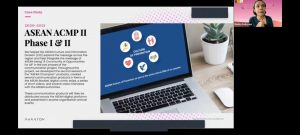The Vocational Education Program at the Universitas Indonesia (UI) is a vocational higher education that produces Associate Expert graduates at the Diploma 3 (D3) level and Applied Bachelors at the Diploma 4 (D4) level. UI Vocational graduates are directed to master skills in certain work fields as workers in industry, government/private institutions, or self-employed.
In order to increase students’ understanding of the importance of marketing communication strategies to increase brand awareness, the UI Vocational Media Production study program initiated a guest lecturer lecture entitled “Sharing on Strategic Integrated Marketing Communication”. The guest lecture presented the Strategic Director of Phantom Indonesia, Nadia Andayani, M.A., as a resource person to thoroughly explore Integrated Marketing Communication (IMC) guided by the lecturer of the UI Vocational Media Production study program, Margareta Manalu, M.Sc., as the moderator.
Submission of messages by a company or brand, often gets various responses from the public, both in marketing commercial and non-commercial products. Through a marketing communication strategy carried out by a brand, awarenesswill be created from the public on the existence of products from the brand.
Nadia shared her experience in using the IMC strategy at Phantom Indonesia. “We use the frameworkin IMC planning through six stages, namely the first situation analysis; both objectives; third strategy; fourth tactics; the five actions; and the six controls. To market a product, the six stages should be carried out so that the delivery of messages to the public is appropriate and appropriate,” said Nadia in her presentation.

At the situation analysis stage, Nadia said three things needed to be analyzed. The first is a macro analysis which includes various factors that are relevant and cannot be influenced by the company, such as economic, social, market trends, and others. Then the second thing is that micro analysis includes factors that are relevant and can be influenced by the company, such as competitor analysis, customer insights, and so on. “The third is internal analysis. For example, related to product, current performance, resources, and internal capabilities. All three are summarized in the form of a SWOT analysis and will create a situation analysis that suits the needs of the brand,” said Nadia again.
Nadia further explained the next stage, namely objectives. In the second stage of IMC, this is the stage where the company that will market the product must set the target and objectivity of a brand on a monthly/quarterly/annual basis. “The concept of Objectives and Key Results (OKR) or Key Performance Indicators (KPI) can be used to measure and produce the right marketing based on the SWOT analysis that has been done. After that, through the strategystage, we need to conceptualize what strategies are appropriate and suitable to be carried out so that product marketing can be effective, such as message strategy, segmentation, targeting, positioning, IMC toolsused, creative strategy, to the media strategy that is carried out, “said Nadia.
In the tacticsstage, creative execution, schedule and determination of the media used, budget, and project timeline must be done together so that the marketing objectives can be achieved properly. After going through these stages, the actionsor projects can be carried out according to the plan. In this process, various kinds of dynamic changes can occur. Involvement of third parties can also be done by the agency to help run the project. Therefore, good communication is needed between the agency and the company or brand.
“Besides, we also control marketing. This control includes pre-test including conducting surveys, FGDs, interviews; monitoringof KPI, OKR, web analytics, and social media listening; as well as post-tests that include user experience reviews, changes in the target’s point of view and others,” said Nadia adding on Monday (30/05/2022).

Finally, Nadia also explained the importance of IMC. “IMC’s role is very important in marketing. The amount of information from various media, both social media, mass media, and others, needs to go through the IMC approach so that the message can be conveyed properly. Then, in every IMC activity, it needs to be supported by strong data analysis and situation analysis so that the results are effective and objective. Lastly, IMC activities must be logical and consistent from beginning to end, and answer product problems experienced by the company or brand that you want to communicate,” said Nadia, closing her presentation.
Writer: Vocational Program Public Relation | Editor: Mariana S
